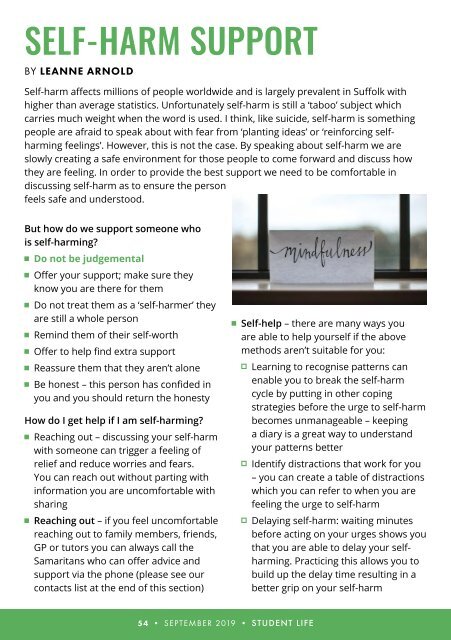Student Life September 2019
Create successful ePaper yourself
Turn your PDF publications into a flip-book with our unique Google optimized e-Paper software.
SELF-HARM SUPPORT<br />
BY LEANNE ARNOLD<br />
Self-harm affects millions of people worldwide and is largely prevalent in Suffolk with<br />
higher than average statistics. Unfortunately self-harm is still a ‘taboo’ subject which<br />
carries much weight when the word is used. I think, like suicide, self-harm is something<br />
people are afraid to speak about with fear from ‘planting ideas’ or ‘reinforcing selfharming<br />
feelings’. However, this is not the case. By speaking about self-harm we are<br />
slowly creating a safe environment for those people to come forward and discuss how<br />
they are feeling. In order to provide the best support we need to be comfortable in<br />
discussing self-harm as to ensure the person<br />
feels safe and understood.<br />
But how do we support someone who<br />
is self-harming?<br />
Do not be judgemental<br />
Offer your support; make sure they<br />
know you are there for them<br />
Do not treat them as a ‘self-harmer’ they<br />
are still a whole person<br />
Remind them of their self-worth<br />
Offer to help find extra support<br />
Reassure them that they aren’t alone<br />
Be honest – this person has confided in<br />
you and you should return the honesty<br />
How do I get help if I am self-harming?<br />
Reaching out – discussing your self-harm<br />
with someone can trigger a feeling of<br />
relief and reduce worries and fears.<br />
You can reach out without parting with<br />
information you are uncomfortable with<br />
sharing<br />
Reaching out – if you feel uncomfortable<br />
reaching out to family members, friends,<br />
GP or tutors you can always call the<br />
Samaritans who can offer advice and<br />
support via the phone (please see our<br />
contacts list at the end of this section)<br />
Self-help – there are many ways you<br />
are able to help yourself if the above<br />
methods aren’t suitable for you:<br />
Learning to recognise patterns can<br />
enable you to break the self-harm<br />
cycle by putting in other coping<br />
strategies before the urge to self-harm<br />
becomes unmanageable – keeping<br />
a diary is a great way to understand<br />
your patterns better<br />
Identify distractions that work for you<br />
– you can create a table of distractions<br />
which you can refer to when you are<br />
feeling the urge to self-harm<br />
Delaying self-harm: waiting minutes<br />
before acting on your urges shows you<br />
that you are able to delay your selfharming.<br />
Practicing this allows you to<br />
build up the delay time resulting in a<br />
better grip on your self-harm<br />
54 • SEPTEMBER <strong>2019</strong> • STUDENT LIFE


















